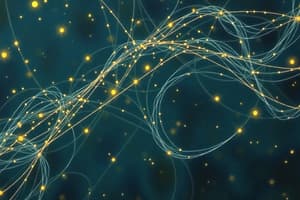Podcast
Questions and Answers
Elixirs are clear, sweetened hydroalcoholic solutions intended for oral use and are usually flavored to enhance their ______.
Elixirs are clear, sweetened hydroalcoholic solutions intended for oral use and are usually flavored to enhance their ______.
palatability
Medicated elixirs are used for the therapeutic effect of the medicinal ______ they contain.
Medicated elixirs are used for the therapeutic effect of the medicinal ______ they contain.
substances
The proportion of ______ in elixirs varies widely because the individual components have different solubility characteristics.
The proportion of ______ in elixirs varies widely because the individual components have different solubility characteristics.
alcohol
Elixirs containing agents with poor water solubility require a greater proportion of ______ for solution.
Elixirs containing agents with poor water solubility require a greater proportion of ______ for solution.
All elixirs contain flavorings to increase their ______.
All elixirs contain flavorings to increase their ______.
Elixirs containing more than 10% to 12% of alcohol are usually ______ and do not require addition of an antimicrobial agent.
Elixirs containing more than 10% to 12% of alcohol are usually ______ and do not require addition of an antimicrobial agent.
One advantage of elixirs over their counterpart solid dosage forms is the flexibility of ______.
One advantage of elixirs over their counterpart solid dosage forms is the flexibility of ______.
Elixirs should be stored in tight, light-resistant containers and protected from excessive ______.
Elixirs should be stored in tight, light-resistant containers and protected from excessive ______.
Elixirs are usually prepared by a simple ______ with agitation.
Elixirs are usually prepared by a simple ______ with agitation.
Alcohol-soluble and ______-soluble components are generally dissolved separately.
Alcohol-soluble and ______-soluble components are generally dissolved separately.
The aqueous solution is added to the ______ solution to maintain the highest possible alcoholic strength.
The aqueous solution is added to the ______ solution to maintain the highest possible alcoholic strength.
Most official and commercial elixirs contain a single ______ agent.
Most official and commercial elixirs contain a single ______ agent.
The average single dose of the medicinal substances is listed in the ______.
The average single dose of the medicinal substances is listed in the ______.
Non medicated elixirs involve the addition of a therapeutic agent to a pleasant-tasting ______.
Non medicated elixirs involve the addition of a therapeutic agent to a pleasant-tasting ______.
Many elixirs not recognized by the USP or NF are sold under ______ names.
Many elixirs not recognized by the USP or NF are sold under ______ names.
An example of an elixir containing only water as a solvent is ______ pepsin elixir.
An example of an elixir containing only water as a solvent is ______ pepsin elixir.
Flashcards are hidden until you start studying
Study Notes
Elixirs
- Clear, sweetened hydroalcoholic solutions for oral use
- Usually flavored for palatability
- Can be medicated or non-medicated
Medicated Elixirs
- Used for therapeutic effect of the medicinal substances they contain
- Contain 4-40% alcohol
Non-Medicated Elixirs
- Employed as vehicles
- Used for:
- Addition of a therapeutic agent to a pleasant-tasting vehicle
- Dilution of an existing medicated elixir
Elixir Composition
- Specific blends of alcohol and water are required to maintain all components in solution
- Proportion of alcohol varies based on water and alcohol solubility of components
- Greater proportion of alcohol needed for components with poor water solubility
- Solvents such as glycerin and propylene glycol are frequently used as adjunctive solvents
- Sweetened with sucrose, sorbitol, glycerin or artificial sweeteners
- High alcoholic content elixirs typically use artificial sweeteners due to sucrose's poor solubility in alcohol
- All elixirs contain flavorings
- Most elixirs have coloring agents
- High alcoholic content elixirs (over 10-12%) are usually self-preserving
- Elixirs are usually prepared by simple solution with agitation or by admixture of liquid ingredients
- Alcohol-soluble and water-soluble components are dissolved separately in alcohol and purified water, respectively
- Aqueous solution is added to the alcoholic solution to maintain the highest possible alcoholic strength
Elixir Dosage
- Typical adult dose: 1-2 teaspoonfuls (5-10 mL)
- Offers flexibility in dosage administration
Elixir Advantages
- Ease of dosage administration to patients with difficulty swallowing
Elixir Disadvantages
- Alcoholic content
- Not suitable for children or individuals avoiding alcohol
Elixir Storage
- Tight, light-resistant containers
- Protected from excessive heat
Official Elixirs
- Contain a single therapeutic agent
- Usually contain 25-100% of an average single dose of a medicinal substance per 5 mL (one teaspoonful)
Unofficial Elixirs
- Many elixirs on the market are sold under trade names
- Examples: B.co elixir, Ferro B elixir, Toniphose elixir
- Lactated pepsin elixir contains only water as a solvent
Studying That Suits You
Use AI to generate personalized quizzes and flashcards to suit your learning preferences.




